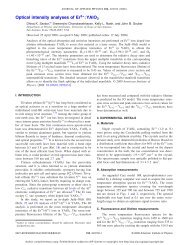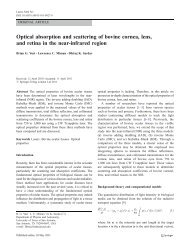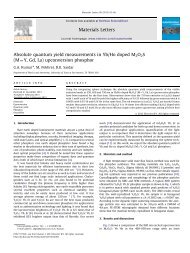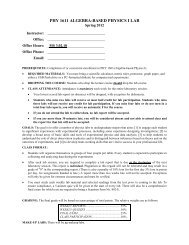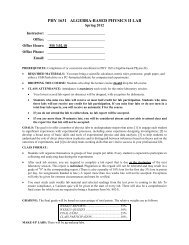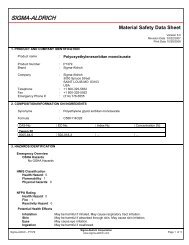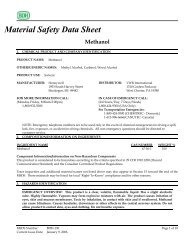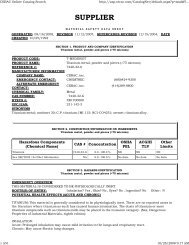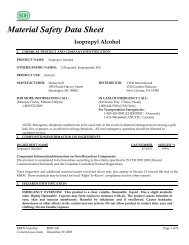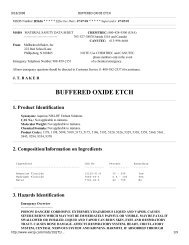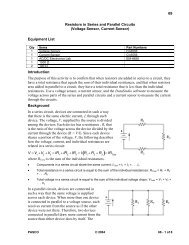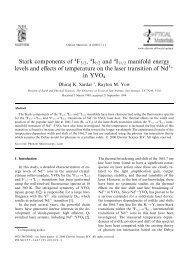Optical characterization of Er3+and Yb3+ co-doped barium ...
Optical characterization of Er3+and Yb3+ co-doped barium ...
Optical characterization of Er3+and Yb3+ co-doped barium ...
Create successful ePaper yourself
Turn your PDF publications into a flip-book with our unique Google optimized e-Paper software.
1912<br />
multiplet manifolds 2Sþ1 LJ to the <strong>co</strong>rresponding lower lying<br />
multiplet manifolds 2S0 þ1 LJ’ <strong>of</strong> Er 3 þ in the present glass was<br />
calculated [11,22,23,26]. Using these line strengths, radiative<br />
transition probabilities from J to J 0 , radiative decay rates, and<br />
branching ratios were calculated and are tabulated in Table 2.<br />
3.2. Infrared and up<strong>co</strong>nversion luminescence spectra<br />
Fig. 2 shows the infrared emission <strong>of</strong> the glass <strong>co</strong>mposition,<br />
where peak emission was observed at 1571 nm with a spectral<br />
bandwidth <strong>of</strong> 210 nm and full width at half max (FWHM) <strong>of</strong> over<br />
91 nm. Fig. 3 shows the up<strong>co</strong>nversion luminescence spectra<br />
obtained for various pump powers under 980 nm excitation with<br />
an inset photograph <strong>of</strong> the green up<strong>co</strong>nversion emission under<br />
60 mW excitation. The emission bands were observed at 533 nm<br />
(green), 547 nm (green) and 670 nm (red), which are assigned to<br />
the 2 H11/2- 4 I15/2, 4 S3/2- 4 I15/2 and 4 F9/2- 4 I15/2 transitions respectively.<br />
The fluorescence branching ratios <strong>of</strong> the up<strong>co</strong>nversion<br />
bands are 24% (533 nm), 64% (547 nm) and 13% (670 nm) respectively.<br />
Since the integrated intensity is highest for the 547 nm<br />
Table 2<br />
Calculated electric dipole radiative transition probabilities (A ed), fluorescence<br />
branching ratios (b JJ 0), and radiative decay rates (t rad) <strong>of</strong> various excited states <strong>of</strong><br />
Er 3 þ in Er 3 þ /Yb 3 þ <strong>co</strong>-<strong>doped</strong> (Ba,La)-tellurite glass at 300 K.<br />
Transitions k (nm) n S ed (10 –20 cm 2 ) A ed bJ-J 0 (%) s rad (ms)<br />
4<br />
I13/2-I15/2 1571 1.9741 2.3215<br />
a<br />
269.74 100 3.7072<br />
4<br />
I11/2-I15/2 988 1.9886 0.7058 260.02 88.79 3.4148<br />
4<br />
-I13/2<br />
2747 1.9678 1.7404 32.81 11.20<br />
4<br />
F9/2-I15/2 656 2.0202 1.5690 2092.28 89.07 0.4257<br />
4<br />
-I13/2<br />
1143 1.9825 0.4358 117.18 4.98<br />
4<br />
-I11/2<br />
1957 1.9707 2.1547 131.78 5.01<br />
4<br />
-I9/2<br />
3472 1.9666 0.5998 7.82 0.33<br />
4<br />
S3/2-I15/2 545 2.0465 0.3531 861.42 77.06 0.8946<br />
4<br />
-I13/2<br />
842 1.9978 0.1088 75.27 6.73<br />
4<br />
-I11/2<br />
1213 1.9805 0.4862 127.14 11.37<br />
4<br />
-I9/2<br />
1645 1.9733 0.4347 53.96 4.83<br />
2<br />
H9/2-I15/2 408 2.1168 0.2052 1353.64 27.14 0.2005<br />
4<br />
-I13/2<br />
554 2.0438 0.6366 1681.56 33.72<br />
4<br />
-I11/2<br />
694 2.0141 0.7726 1147.26 23.00<br />
4<br />
-I9/2<br />
821 1.9996 0.6192 649.06 13.01<br />
4<br />
F9/2 1076 1.9848 0.3434 155.61 3.12<br />
-<br />
a<br />
269.74 (Aed¼207.12þAmd¼62.62)—including the magnetic dipole <strong>co</strong>ntribution<br />
Amd. Cross section (cm 2 )<br />
6.0x10 -21<br />
4.0x10 -21<br />
2.0x10 -21<br />
0.0<br />
Absorption<br />
Emission<br />
1450 1500 1550 1600 1650<br />
Wavelength (nm)<br />
Fig. 2. NIR emission cross section spectrum <strong>of</strong> the glass under 980 nm laser<br />
excitation along with the overlap <strong>of</strong> the absorption <strong>co</strong>rresponding to 4 I 15/2- 4 I 13/2.<br />
The Y-axis is in cross section normalized with respect to the absorption peak<br />
intensity.<br />
M. Pokhrel et al. / Journal <strong>of</strong> Luminescence 132 (2012) 1910–1916<br />
Intensity (arb.units)<br />
800<br />
600<br />
400<br />
200<br />
100<br />
Laser Power (mW)<br />
200<br />
180<br />
160<br />
140<br />
120<br />
100<br />
80 60<br />
40<br />
20<br />
500 550 600<br />
Wavelength (nm)<br />
650 700<br />
Up<strong>co</strong>nversion Intensity (arb.units)<br />
533nm - Slope-2.3<br />
547nm - Slope-2.2<br />
670nm - Slope-2.1<br />
Laser Power (mW)<br />
Fig. 3. Up<strong>co</strong>nversion emission spectrum under 980 nm excitation. Inset shows the<br />
dependence <strong>of</strong> the intensity <strong>of</strong> the up<strong>co</strong>nversion bands under 980 nm excitation<br />
on pump power. Photograph in the inset is the green up<strong>co</strong>nversion emission under<br />
60 mw excitation power. (For interpretation <strong>of</strong> the references to <strong>co</strong>lor in this<br />
figure, the reader is referred to the web version <strong>of</strong> this article.)<br />
Energy<br />
20<br />
16<br />
12<br />
8<br />
4<br />
0<br />
x (10 3 cm -1 )<br />
2 F5/2<br />
980 nm<br />
2 F7/2<br />
Yb 3+<br />
ET<br />
980 nm<br />
ESA<br />
TPA<br />
1529 nm<br />
523 nm<br />
Er 3+<br />
4 F7/2<br />
2 H11/2<br />
4 S3/2<br />
4 F9/2<br />
4 I9/2<br />
Er 3+<br />
band, the <strong>co</strong>lor <strong>of</strong> the sample appears pure green as shown in inset<br />
<strong>of</strong> Fig. 3. The up<strong>co</strong>nversion process in YbEr system is well understood<br />
in several materials [11,31] and is briefly explained for this<br />
sample using the following energy level diagram as shown in<br />
Fig. 4. Emission bands were observed at 533 nm, 547 nm, and<br />
670 nm and are assigned to the 2 H11/2- 4 I15/2, 4 S3/2- 4 I15/2, and<br />
4 F9/2- 4 I 15/2 transitions respectively. The appearance <strong>of</strong> both the<br />
green and red emission bands can be explained on the basis <strong>of</strong><br />
various processes such as excited state absorption (ESA) and<br />
energy transfer (ET). When the 4 I11/2 level is excited under<br />
980 nm directly through Er 3 þ or through Yb 3 þ excitation photons,<br />
part <strong>of</strong> the excitation energy at the 4 I11/2 level relaxes<br />
MP<br />
546 nm<br />
672 nm<br />
CR<br />
ET<br />
4 I11/2<br />
4 I13/2<br />
4 I15/2<br />
Fig. 4. Energy level diagram <strong>of</strong> Yb 3þ <strong>co</strong>-<strong>doped</strong> with Er 3þ and the possible excitation<br />
and de excitation mechanisms giving rise to the observed up<strong>co</strong>nversion bands.




